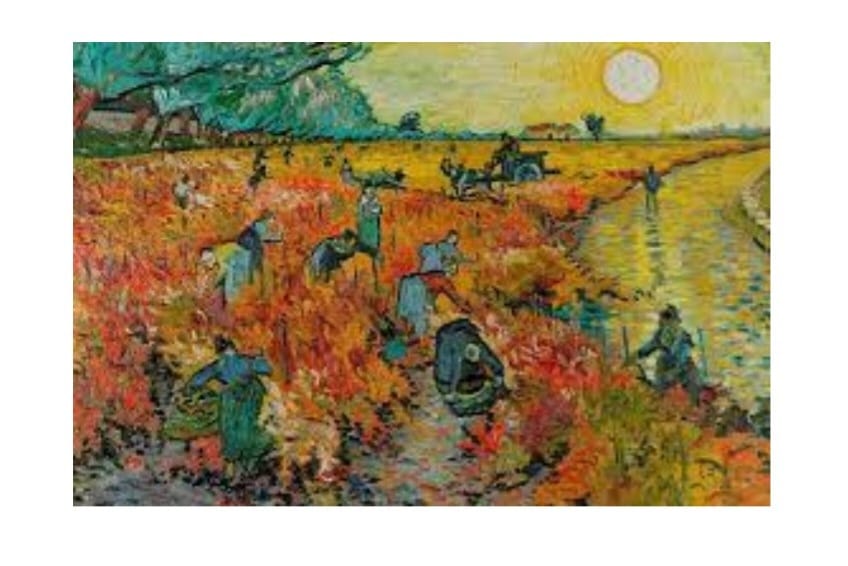Title: The Red Vineyard
Artist : Vincent van Gogh
Size: 75 cm x 93 cm
Medium: Oil on canvas
"The Red Vineyard," which holds a significant place in art history as it is often cited as the only piece Vincent van Gogh sold during his lifetime. This work exudes the passionate and emotion-driven style that van Gogh is renowned for.
Set against an early evening sky, "The Red Vineyard" swells with the fiery tones of autumn. At a glance, it captures a group of laborers amidst the harvest. The vineyard stretches across the middle ground, with rows of grapevines drenched in shades of red and orange, mimicking the hues of the setting sun. The colors undulate with an almost tangible vibrancy, imparting a sense of the land's bountifulness.
Though relatively small in size, this canvas is immeasurable in its visual impact. Van Gogh's paint handling is characteristically expressive; the brushwork is loose, and the surface alive with movement. Each stroke contributes to a sense of dynamism and rhythm that is palpable?the mark of an artist who paints with his emotions at the forefront. The workers, clothed in garments that blend with the earthy tones around them, are bent over the task at hand. Their presence conveys a narrative of toil and connection to the land. They are integral to the scene, a part of the cycle of nature as much as the vineyard itself. Subtle blues and greens punctuate the reddish terrain, offering pockets of coolness amidst the warmth, contributing to the overall harmony of the piece. Noticeably, the sun hangs in the sky, its orb a pale yellow, almost white, contrasting with the deep blues and fiery colors around it. The sun's position serves as a focal point, slightly off-center, pulling the viewer's perspective towards the horizon, hinting at the end of the day and completion of the harvest.
The river in the background provides a linear element that counterbalances the organic lines of the vineyard and the undulating hills. This waterway reflects the colors of the sky, intertwining cooler hues with the reflection of the sun, creating a cohesive palette throughout the painting. Here, Van Gogh shows his mastery of color theory, using complementary colors to intensify the visual experience. The painting exudes emotion, an intense feeling that goes beyond mere representation of a scene. There is a sense of urgency, perhaps reflective of van Gogh's own psychological state at the time. The artist's thick, impasto brushstrokes confer texture and dimensionality, allowing the viewer to feel the weight of the grapes, the roughness of the workers' hands, and the soft warmth of the sinking sun. "The Red Vineyard" also offers insight into van Gogh's fascination with the lives of peasants and workers, following in the vein of his earlier works, like "The Potato Eaters." It speaks to his empathy and respect for the working class, a common theme throughout his art.
Van Gogh's use of color was revolutionary, and this painting is a testament to his innovative approach. He was not afraid to use color to convey emotion over realism, and this choice is evident in "The Red Vineyard." There's a psychological intensity in how the landscape seems to ignite under the setting sun, a sense that the earth itself is alive with the same fire that burned within van Gogh.
In conclusion, "The Red Vineyard" is more than a depiction of rural labor; it is a symphony of color, emotion, and texture. It's a vivid, pulsating moment captured on canvas by an artist who saw the world through a prism of intense emotion and translated it into a language of swirling color and light. Van Gogh's unique vision continues to captivate audiences and stands as a poignant reminder of his legacy? a legacy marked by passion, innovation, and an undying affinity for the beauty found in the ordinary.